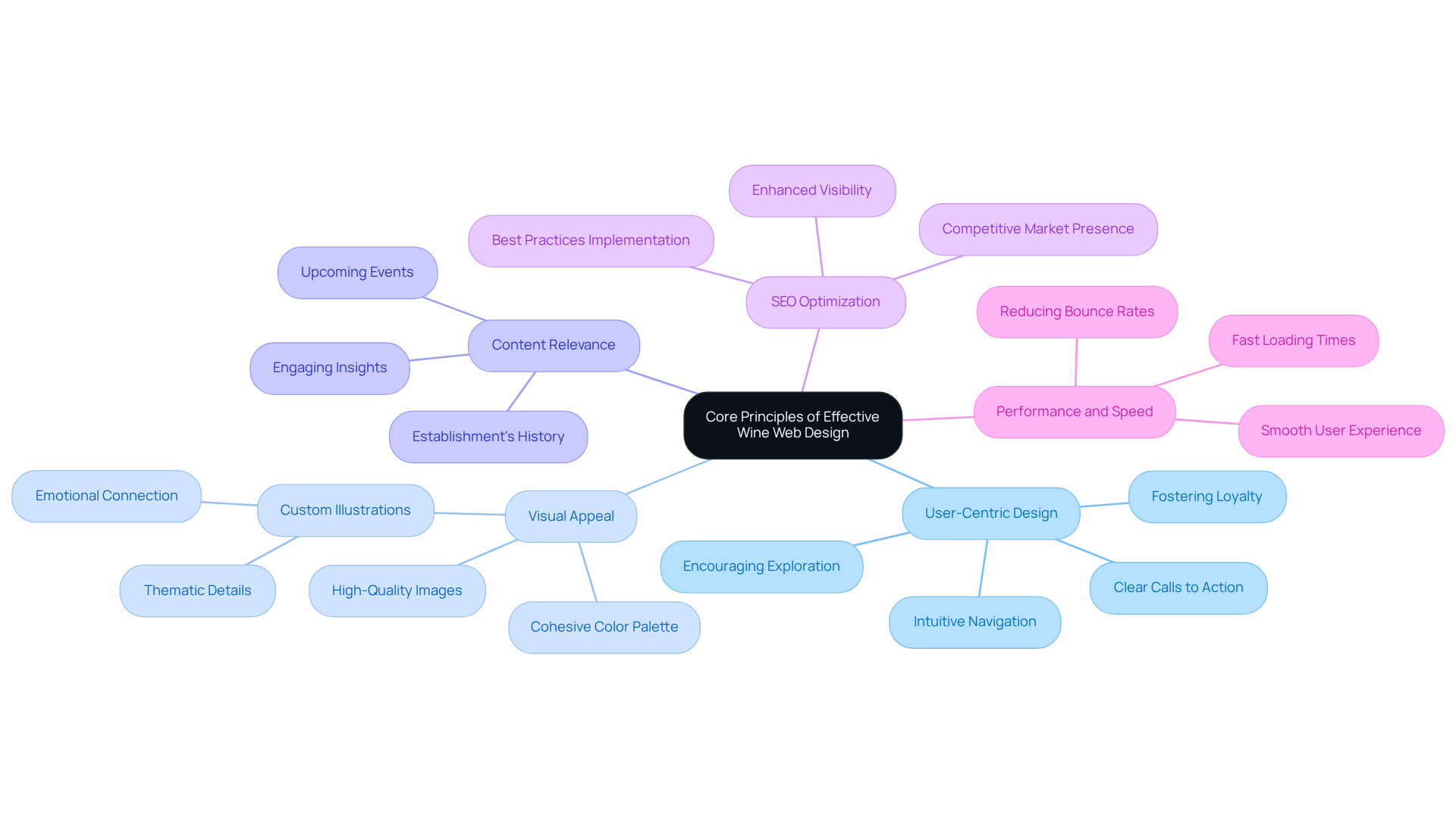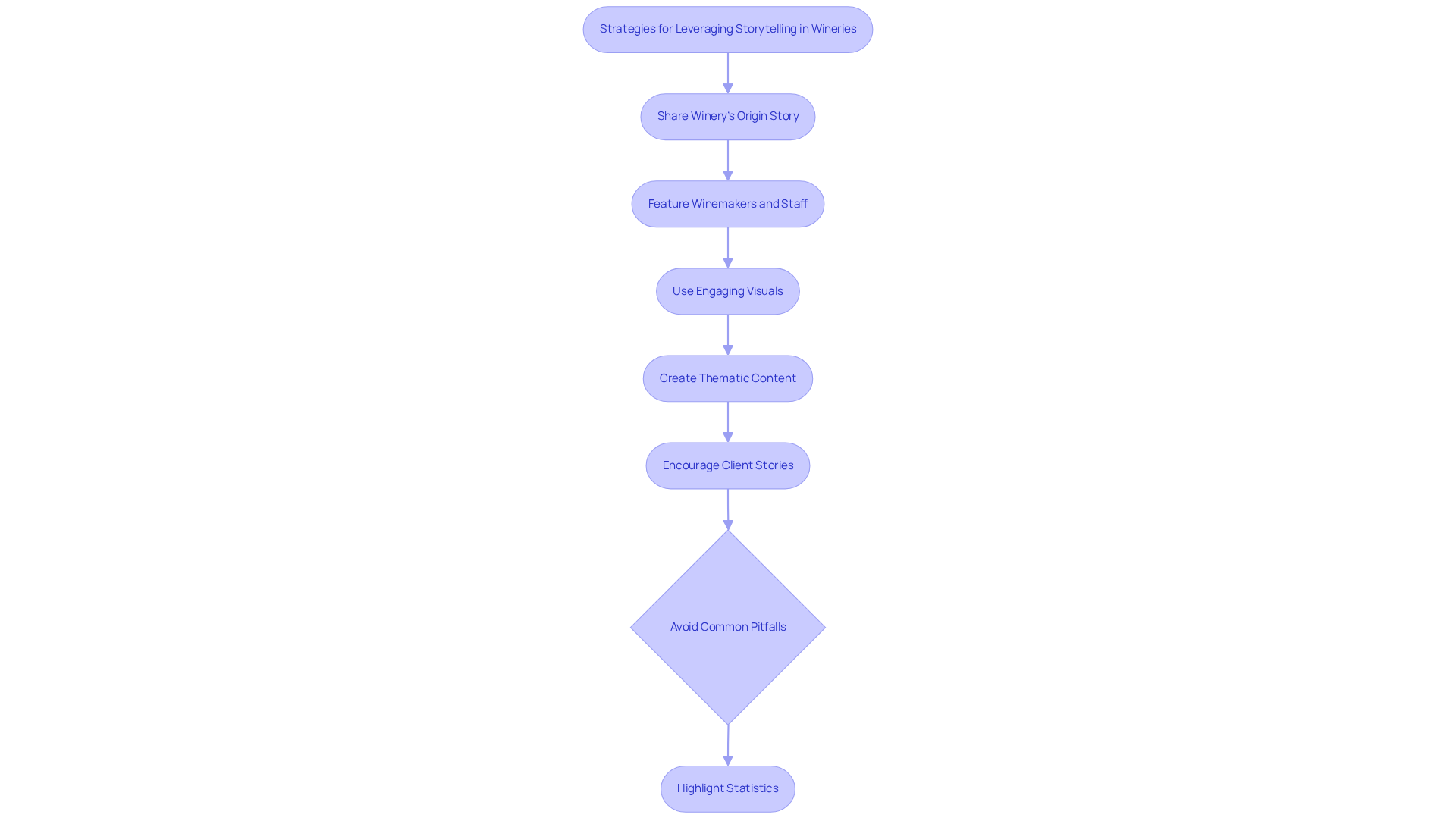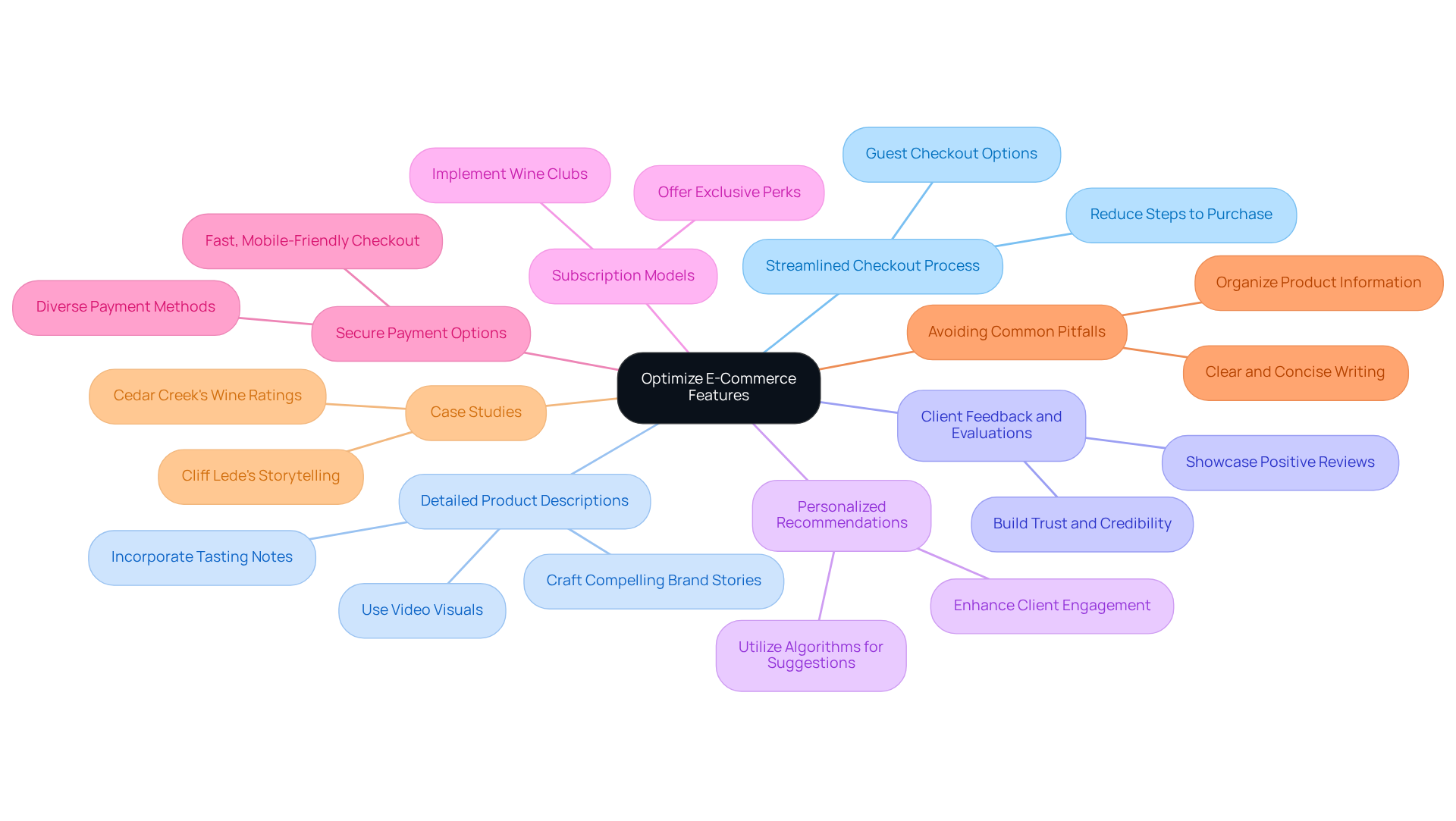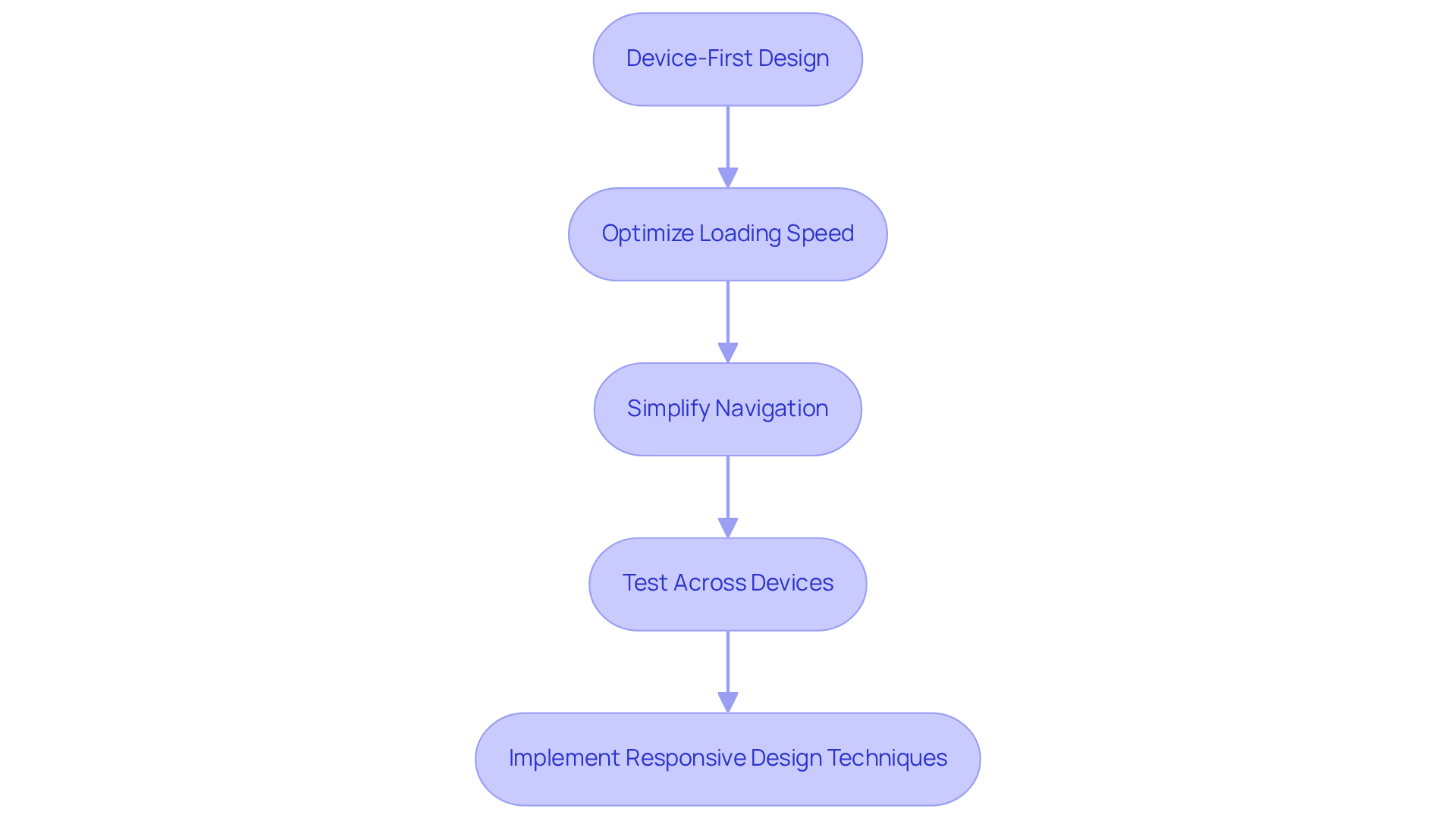Overview
This article presents best practices for effective wine web design that significantly enhance consumer engagement. It underscores the critical role of:
- User-centric design
- Visual appeal
- Relevant content
- SEO optimization
- Mobile responsiveness
Each of these elements plays a vital part in crafting an engaging online presence that not only attracts but also retains customers, ultimately driving direct-to-consumer revenue.
Introduction
Creating an engaging online presence is essential for wineries aiming to thrive in a competitive market. Effective wine web design not only attracts visitors but also transforms them into loyal customers through user-centric approaches, captivating visuals, and compelling storytelling.
However, with the rapid evolution of digital trends, how can wineries ensure their websites not only meet current standards but also stand out in 2025? This article delves into best practices for wine web design, offering actionable insights that can elevate engagement and drive sales in the ever-changing landscape of e-commerce.
Establish Core Principles of Effective Wine Web Design
To create an effective wine website that drives direct-to-consumer revenue, it is essential to focus on several core principles:
- User-Centric Design: Prioritizing user experience is paramount. An intuitive navigation system and clear calls to action enable visitors to find information swiftly, encouraging exploration and enhancing engagement. This approach not only captivates casual buyers but also fosters loyalty, transforming them into devoted club members.
- Visual Appeal: High-quality images and a cohesive color palette that reflect the establishment's brand identity are crucial. A visually appealing site captivates visitors, fostering an emotional connection to the brand. For example, the Vinaty website redesign incorporated custom illustrations that evoked the vineyard atmosphere, featuring thematic details such as wine glasses and grapevines. This significantly enhanced user interaction and emotional appeal.
- Content Relevance: Engaging and informative content is vital. Providing valuable insights about the wines, the establishment's history, and upcoming events keeps users engaged and motivates them to return. This relevance strengthens the brand narrative and values.
- SEO Optimization: Implementing SEO best practices is necessary to enhance visibility in search engines. This facilitates the discovery of the winery online by potential patrons, which is essential in a competitive market where online presence can greatly influence sales and client loyalty.
- Performance and Speed: Optimizing the website for fast loading times is critical. Slow websites lead to high bounce rates and lost sales opportunities. A smooth experience is crucial for retaining visitors and converting them into buyers, ultimately supporting sustainable growth in the direct-to-consumer market.
By adhering to these principles, wine producers can utilize wine web design to create websites that not only attract visitors but also convert them into loyal customers. This drives consistent growth and enhances their direct-to-consumer strategies.

Leverage Storytelling to Connect with Consumers
To effectively leverage storytelling and drive direct-to-consumer revenue, wineries must adopt several key strategies:
- Share the Winery's Origin Story: By emphasizing the history, values, and mission of the winery, an emotional connection with customers is fostered, making them feel linked to the brand. This connection enhances customer loyalty and supports strategic capital planning initiatives.
- Feature Winemakers and Staff: Presenting profiles and interviews of the individuals behind the wines personalizes the brand, allowing patrons to connect with the artisans who create their preferred wines. This personal touch can lead to heightened customer engagement and increased sales.
- Use : Incorporating videos and images that narrate the story of the vineyard, the winemaking process, and the unique characteristics of the wines enhances the narrative, making it more relatable. Effective visual storytelling significantly influences audience engagement and drives revenue growth.
- Create Thematic Content: Developing content around themes such as sustainability, family traditions, or local partnerships helps patrons understand the winery's values and commitment to quality. This thematic approach resonates deeply with consumers, fostering loyalty and trust, which are essential for long-term capital planning.
- Encourage Client Stories: Inviting clients to share their experiences with the winery—through testimonials, social media posts, or blog contributions—builds community and provides authentic content that resonates with potential buyers. Engaging customers in this manner not only strengthens the brand's narrative but also enhances its credibility, potentially increasing sales.
- Avoid Common Pitfalls: Wineries should be cautious of overcomplicating their stories or failing to connect emotionally with their audience. Maintaining an authentic and relatable narrative is crucial for effective storytelling.
- Highlight Statistics: Incorporating relevant statistics, such as the increase in e-commerce order volume during market expansions, supports the effectiveness of storytelling in enhancing brand connection. For instance, vineyards that successfully convey their narratives have experienced considerable growth in customer interaction and sales, favorably influencing their financial planning strategies.
By applying these strategies in wine web design, vineyards can craft engaging stories that not only attract customers but also cultivate enduring connections, ultimately promoting sustainable growth and loyalty in the competitive wine sector.

Optimize E-Commerce Features for Enhanced User Experience
To enhance e-commerce capabilities, wineries must prioritize the following strategies:
- Streamlined Checkout Process: A simplified checkout process is crucial. Reducing the number of steps required to complete a purchase and offering guest checkout options can significantly decrease cart abandonment rates, leading to higher conversion rates.
- Detailed Product Descriptions: Comprehensive product descriptions are essential for informed buyer decisions. Wineries should incorporate tasting notes, food pairings, and production methods into their . Research indicates that well-placed product descriptions can boost conversions by up to 78%, making this a vital aspect of online sales. Incorporating video visuals can further enhance engagement, as 92% of online shoppers find them to be the most influential element impacting their buying behavior. Crafting compelling brand stories around these descriptions can also transform casual buyers into loyal club members, a strategy emphasized by Enocap, especially through effective wine web design.
- Client Feedback and Evaluations: Integrating client feedback and evaluations fosters trust and credibility. Studies show that 91% of consumers aged 18-34 trust online reviews as much as personal recommendations, highlighting the importance of showcasing positive feedback to influence purchasing decisions.
- Personalized Recommendations: Utilizing algorithms to suggest wines based on previous purchases or browsing behavior can enhance the shopping experience. Tailored marketing has been demonstrated to boost client engagement and repeat purchases, making it a powerful instrument for vineyards. Enocap's strategies for transforming family-owned vineyards emphasize the importance of personalized approaches in driving loyalty and growth, particularly through effective wine web design.
- Subscription Models: Wineries should consider implementing subscription models, such as wine clubs, which are becoming significant revenue drivers. These models not only provide consistent revenue but also foster customer loyalty through exclusive offerings. Enocap's proven strategies for scaling wine clubs can assist producers in optimizing their wine web design for better business outcomes.
- Secure Payment Options: Providing a variety of secure payment methods, including credit cards, PayPal, and digital wallets, caters to diverse buyer preferences. Ensuring a fast, mobile-friendly checkout process is essential, as a seamless experience can significantly impact overall sales performance.
- Avoiding Common Pitfalls: Wineries should be cautious of common pitfalls in e-commerce practices, such as using dense paragraphs in product descriptions, which can deter readers. Clear and concise writing enhances readability and encourages purchases.
- Case Studies: For practical insights, establishments can look to examples like Cedar Creek, which effectively summarizes wine ratings on their product pages, enhancing consumer understanding and engagement. Additionally, leveraging Enocap's strategic capital planning can unlock growth opportunities through tailored debt, equity, and acquisition solutions, further enhancing the establishment's e-commerce success.

Ensure Mobile Responsiveness for Broader Accessibility
To ensure mobile responsiveness, wineries must adopt a strategic approach:
- Embrace a Device-First Design Strategy: Prioritize users of portable devices by designing the website with their needs in mind from the outset. This guarantees that all components are easily reachable on smaller displays, accommodating the increasing number of shoppers who favor shopping on their devices.
- Optimize Loading Speed: Quick loading times are essential, as research indicates that 52% of consumers abandon purchases on their devices due to slow website performance. Compress images and streamline code to enhance loading speed, which is vital for retaining potential customers.
- Simplify Navigation: Create a user-friendly navigation menu that is intuitive for touch screens. Ensure buttons and links are large enough for easy tapping, as 76% of adults in the U.S. make purchases using smartphones, highlighting the need for seamless navigation.
- Test Across Devices: Regularly check the website on different handheld devices and browsers to ensure consistent performance and user experience. With over 4.8 billion , ensuring compatibility across devices is essential for reaching a wider audience.
- Implement Responsive Design Techniques: Utilize responsive design frameworks that automatically adjust the layout based on screen size. This method not only improves user experience but also corresponds with the trend of commerce on portable devices, which is expected to represent 59% of total retail eCommerce sales by 2025. Furthermore, commerce sales from smartphones reached $2.2 trillion in 2023, underscoring the importance of optimization for wineries. Clients who enhanced their user interface for handheld devices reported a 30% rise in user engagement within three months, showcasing the effectiveness of a device-first strategy. Additionally, with a cart abandonment rate of 75.5% on mobile devices, effective mobile design is crucial for retaining customers.

Conclusion
Creating an effective wine website requires a multifaceted approach that prioritizes user engagement, aesthetic appeal, and seamless functionality. By emphasizing user-centric design, wineries can craft experiences that not only attract visitors but also convert them into loyal customers. This central idea underscores the critical role of a well-designed online presence in driving direct-to-consumer sales.
The article delineates essential strategies, highlighting the significance of:
- Storytelling to forge emotional connections with consumers
- Optimizing e-commerce features for a smooth shopping experience
- Ensuring mobile responsiveness to cater to the increasing number of mobile shoppers
Each of these elements is vital in enhancing user experience, fostering loyalty, and ultimately driving revenue growth for wineries.
As the wine industry continues to evolve, embracing these best practices is imperative for maintaining competitiveness. Wineries are encouraged to implement these strategies to enhance their web design while building enduring relationships with their customers. By prioritizing user experience and storytelling, wineries can establish a compelling online presence that resonates with consumers and supports sustainable growth in a rapidly changing market.
Frequently Asked Questions
What are the core principles of effective wine web design?
The core principles include user-centric design, visual appeal, content relevance, SEO optimization, and performance and speed.
Why is user-centric design important for a wine website?
User-centric design prioritizes user experience, enabling intuitive navigation and clear calls to action, which helps visitors find information quickly and encourages exploration and engagement.
How does visual appeal affect a wine website?
Visual appeal, through high-quality images and a cohesive color palette that reflects the brand identity, captivates visitors and fosters an emotional connection to the brand, enhancing user interaction.
What role does content relevance play in a wine website?
Engaging and informative content about the wines, the establishment's history, and upcoming events keeps users engaged and motivates them to return, strengthening the brand narrative and values.
Why is SEO optimization necessary for a wine website?
SEO optimization enhances visibility in search engines, facilitating the discovery of the winery online by potential patrons, which is crucial in a competitive market for influencing sales and client loyalty.
How does website performance and speed impact user experience?
Optimizing the website for fast loading times is critical, as slow websites lead to high bounce rates and lost sales opportunities, making a smooth experience essential for retaining visitors and converting them into buyers.




